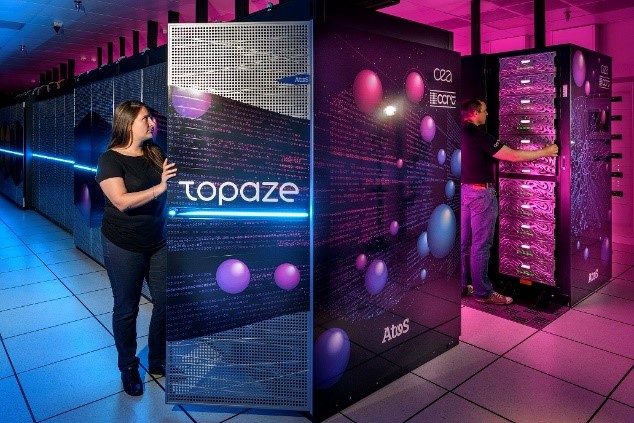"Topaze": a new computer at the CCRT co-designed by Atos and the CEA to meet the challenges of high-performance computing and data processing
Paris, France – June 23 2021
The CEA and its partners at the Research and Technology Computing Center (CCRT) have invested in a new supercomputer, named ‘Topaze’, based on the BullSequana XH2000 solution from Atos, and installed in the CEA’s Very Large Computing Center (TGCC[1]) at Bruyères-le-Châtel in Essonne (south of Paris). It will be open to the first users at the end of June 2021, to start the ‘Grand Challenges’ phase, for very large-scale simulations.
‘Topaze’ is part of Atos’ range of HPC supercomputers, acquired following a call for tenders, and is the result of joint R&D by Atos and the CEA’s Military Applications Directorate (DAM). It has a peak computing power of around 8.8 petaflops[2].
The new computer includes a general-purpose partition of 864 nodes equipped with the latest AMD EPYC Milan 7763 processors, an accelerated partition of 48 nodes based on Nvidia A100 processors and four very large memory nodes. A DDN[3] storage system with a capacity of approximately 3 petabytes and a bandwidth of 280 gigabytes/s completes the computation part.
 As partners of the CCRT, the teams from ArianeGroup, the CEA, Cerfacs, EDF, France Génomique, IFPEN, Ineris, Ingeliance, IRSN, L’Oréal, Michelin, Onera, the Safran Group, Synchrotron SOLEIL, TechnicAtome, Thales Defence Mission Systems, Thales Alenia Space and Valeo will have access to the latest generation of computing and data processing resources required for the success of their projects.
As partners of the CCRT, the teams from ArianeGroup, the CEA, Cerfacs, EDF, France Génomique, IFPEN, Ineris, Ingeliance, IRSN, L’Oréal, Michelin, Onera, the Safran Group, Synchrotron SOLEIL, TechnicAtome, Thales Defence Mission Systems, Thales Alenia Space and Valeo will have access to the latest generation of computing and data processing resources required for the success of their projects.
High-performance digital simulation is an indispensable asset for innovation in many fields, such as studies on the development of new aircraft and helicopter engines, energy and ecological transition technologies, the design and safety of nuclear reactors, environmental risk analysis, the design of new ‘flexible’ satellites, the study of proteins and the decoding of the genome, the design and manufacture of tires and integrated systems for automobiles, research into new materials, and the development of more environmentally friendly cosmetics.
The CCRT’s partnership model, established in 2003, has demonstrated its ability to respond in a sustainable way tailored to the growing needs of industry. It offers a wide range of skills in the field of high-performance calculations and processing, combining security, innovation and flexibility in the use of resources. This model is based on numerous discussions and working sessions between the partners in order to share needs and feedback.
###
Press contacts:
Laura Fau | laura.fau@atos.net | +33 6 73 64 04 18 | @laurajanefau
Tuline Laeser | tuline.laeser@cea.fr | +33 6 12 04 40 22 | @CEA_Officiel
About Atos
Atos is a global leader in digital transformation with 105,000 employees and annual revenue of over € 11 billion. European number one in cybersecurity, cloud and high performance computing, the Group provides tailored end-to-end solutions for all industries in 71 countries. A pioneer in decarbonization services and products, Atos is committed to a secure and decarbonized digital for its clients. Atos operates under the brands Atos and Atos|Syntel. Atos is a SE (Societas Europaea), listed on the CAC40 Paris stock index.
The purpose of Atos is to help design the future of the information space. Its expertise and services support the development of knowledge, education and research in a multicultural approach and contribute to the development of scientific and technological excellence. Across the world, the Group enables its customers and employees, and members of societies at large to live, work and develop sustainably, in a safe and secure information space. www.atos.net
About the CEA
The CEA is a key player in research, development and innovation in four main areas: energy transition, digital transition, technology for the medicine of the future and defense and security. With a workforce of 20,000 people, based in nine sites equipped with very large-scale research infrastructures, the CEA actively participates in collaborative projects with a large number of academic and industrial partners, in France, Europe and worldwide.
For more information: www.cea.fr
Through its Military Applications Division (CEA-DAM), the CEA is tasked with overseeing France’s defense and security programs. It designs, manufactures and ensures the safety and reliability of France’s nuclear deterrent warheads. It designs and makes the nuclear steam supply systems that power the French Navy’s vessels. The CEA also provides technical support to the Authorities aimed at preventing nuclear proliferation and terrorism, as well as providing its expertise to advise the French Defense Ministry on assessing and managing the effects of conventional weapons systems and their vulnerability.
[1] The CEA’s Very Large Computing Center (TGCC) is an infrastructure operated by teams from the DAM Île-de-France center and designed to host supercomputers, with all the computing resources and services adapted to high-performance digital processing.
[2] 1 million billion operations per second.
[3] DataDirect Networks
Photo caption: Topaze, the new supercomputer at the CCRT ©CEA
